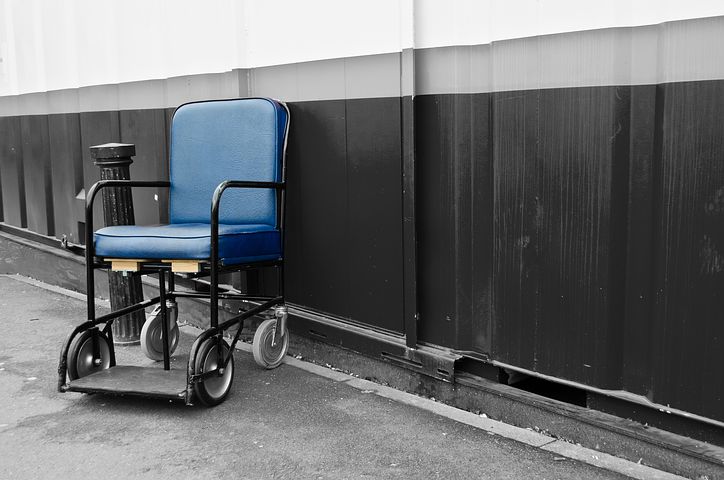
By: Elizabeth Echard, Staff Writer
Currently, forty million Americans have a disability.[1] Of those forty million disabled Americans, sixteen million voted in 2016.[2] That shows a mere 40% of disabled citizens vote, compared to the 58% of United States citizens, as a whole, that voted in 2016.[3] Many issues are leading to this decrease in turn out of disabled voters, with the most prevalent issue being poll worker training regarding accessibility of polling locations and machines.
Kathy Hoell, a sixty-two-year-old woman from Nebraska, uses a powered wheelchair and has a brain injury that causes her to speak in a strained, raspy voice.[4] For decades, poll workers have been telling Kathy that she is not smart enough to cast a ballot, have led her to stairs that she could not climb, and have obstructed her from voting because they had not powered on the disability accessible voting machine.[5] The difficulties that Hoell has faced are not uncommon for voters with disabilities in America.[6]
These difficulties are persistently growing with new legislation in various states reverting to paper ballots.[7] Many voters with disabilities are unable to mark a paper ballot without requiring assistance.[8] This assistance may be rendered using special voting machines with headphones or other types of modifications.[9] Many poll workers, however, are extremely uncomfortable operating these disability accessible machines.[10] For example, in a prior election, a voter with disabilities called the local election officials for her precinct to report that the accessible machine at her precinct was turned off, placed in a corner, and covered with a flower wreath hanging on it.[11] This scenario results from a lack of training for the poll workers, which, in turn, leads to the poll workers feeling intimidated by the machines and opting to not use them on Election Day.[12]
The two major issues that disabled voters face are (1) voter registration and (2) lack of poll worker training in the areas of accessible polling locations and operation of accessible machines. Title II of the Americans with Disabilities Act of 1990 provides that state and local governments must ensure that those with disabilities will not face barriers when registering to vote.[13] Additionally, the National Voter Registration Act requires that state-funded programs that aid disabled citizens give those citizens the opportunity to vote as well as any necessary assistance to complete and return the voter’s registration, providing these services in the home of a disabled citizen if necessary.[14] In addition to such federal legislation, some states have passed automatic voter registration laws.
Automatic voter registration brings two simple changes to the way American voters traditionally register.[15] The first change is an “opt out” system versus an “opt in” system.[16] By creating an “opt out” system, citizens who are eligible to vote and interact with any government agencies become registered to vote, or have their voting information updated, unless they affirmatively decline.[17] The second change is that government agencies electronically transfer the voter information to election officials instead of using voter registration forms.[18]
Automatic voter registration enables disabled voters to register to vote more easily in the states that have passed the reform. Automatic voter registration helps to circumvent the paperwork and other issues that disabled voters face regarding voter registration and, therefore, furthers the requirements of the Americans with Disabilities Act and the National Voter Registration Act.
Disabled voters who pass the hurdle of registering to vote may subsequently face the physical barriers to accessibility at their polling location.[19] Polling locations are situated in a variety of public places, from gyms to schools to libraries to basements.[20] When a physical barrier exists, poll workers are required to “temporarily transform” a polling location if at all possible by transforming steps into a ramp or reserving parking spaces that are closer to the door if parking for disabled voters is an issue. Also, with many jurisdictions switching back to paper ballots, disabled voters have to rely on accessible machines to mark their ballots.[21] Due to lack of poll worker training, the transformation to accessible polling locations and operation of accessible machines can fall through the cracks frequently. Although the Americans with Disabilities Act requires poll workers to be trained in creating accessible polling locations and operating accessible machines, these requirements are not always met. While automatic voter registration seems to be a step in the right direction to overcoming the hurdle of voter registration for disabled voters, more, new legislation needs to be explored regarding the enforcement of current legislation. The Americans with Disabilities Act provides for the accessibility for disabled voters, but perhaps some legislation regarding sanctions for failure to comply with the Act needs to be explored.
Sources:
[1]Kristen Bialik, 7 Facts About Americans with Disabilities, http://www.pewresearch.org/fact-tank/2017/07/27/7-facts-about-americans-with-disabilities/ (July 27, 2017).
[2]Statistics and Data, AAPD, https://www.aapd.com/advocacy/voting/statistics/ (2018).
[3]Michael D. Regan, What Does Voter Turnout Tell Us About the 2016 Election?, https://www.pbs.org/newshour/politics/voter-turnout-2016-elections (November 20, 2016).
[4]Matt Vasilogambros, How Voters with Disabilities are Blocked from the Ballot Box, PEW Charitable Trusts, https://www.pewtrusts.org/en/research-and-analysis/blogs/stateline/2018/02/01/how-voters-with-disabilities-are-blocked-from-the-ballot-box (February 1, 2018).
[5]Id.
[6]Id.
[7]Id.
[8]Id.
[9]Id.
[10]Id.
[11]Id.
[12]Id.
[13]Tzvi Schectman, The Five Challenges Facing Voters with Disabilities, https://www.friendshipcircle.org/blog/2016/11/07/five-challenges-facing-voters-disabilities/ (November 7, 2016).
[14]Id.
[15]Automatic Voter Registration, Brennan Center For Justice, https://www.brennancenter.org/analysis/automatic-voter-registration (November 7, 2018).
[16]Id.
[17]Id.
[18]Id.
[19]Tzvi Schectman, The Five Challenges Facing Voters with Disabilities, https://www.friendshipcircle.org/blog/2016/11/07/five-challenges-facing-voters-disabilities/ (November 7, 2016).
[20]Id.
[21]Matt Vasilogambros, How Voters with Disabilities are Blocked from the Ballot Box, PEW Charitable Trusts, https://www.pewtrusts.org/en/research-and-analysis/blogs/stateline/2018/02/01/how-voters-with-disabilities-are-blocked-from-the-ballot-box (February 1, 2018).